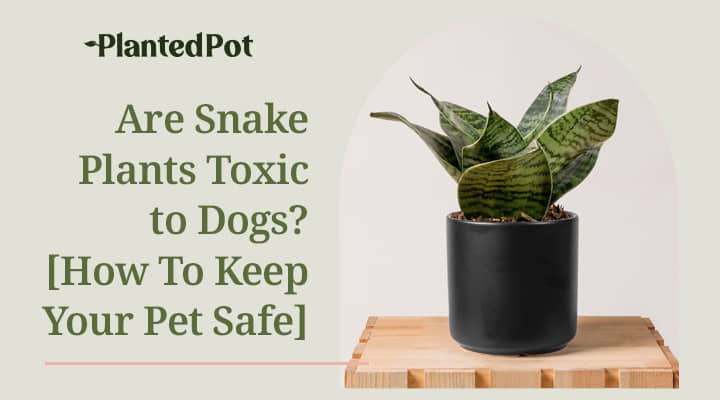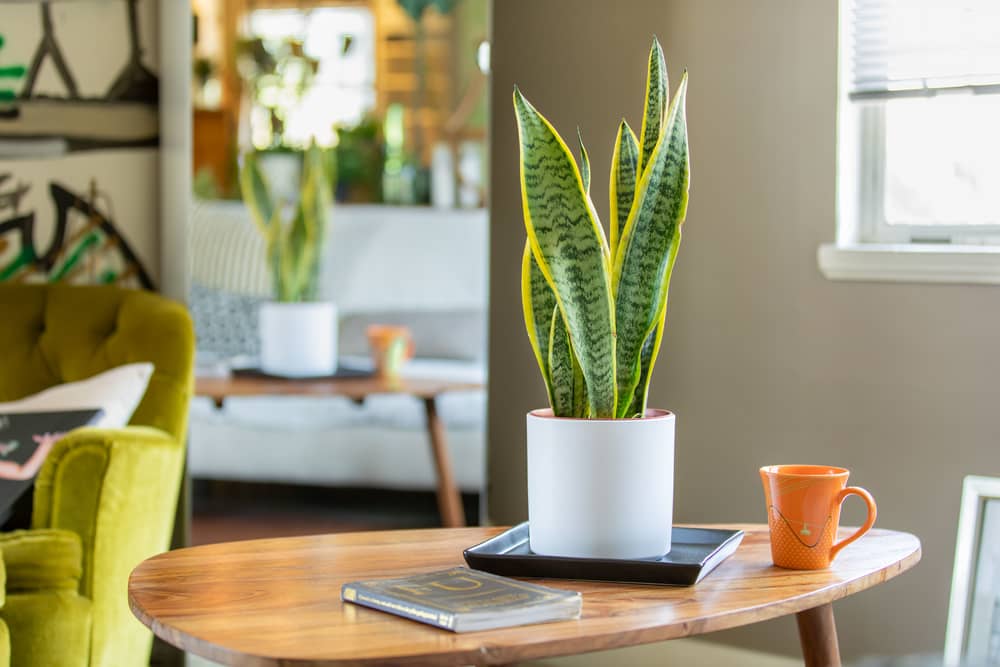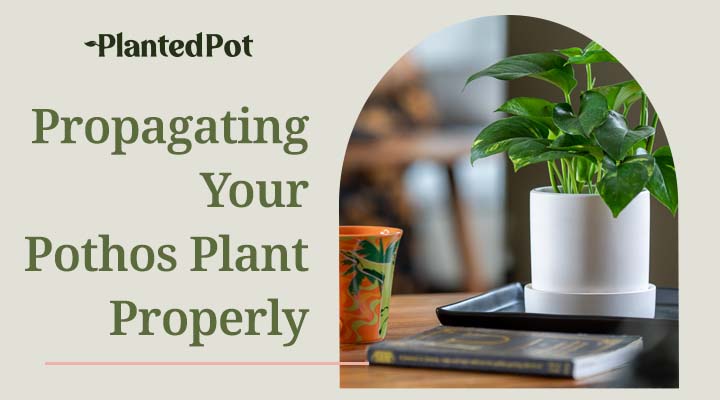
Are Snake Plants Toxic to Dogs? [Protecting Your Pet From Houseplants]
Home / Are Snake Plants Toxic to Dogs? [Protecting Your Pet From Houseplants]

Are Snake Plants Toxic to Dogs? [Protecting Your Pet From Houseplants]
Snake Plants are beautiful, bold, and versatile plants that gardeners love to add to their decor for a pop of green just about anywhere. But if you have a dog, especially one that loves munching on plants, you may need to rethink where you place this plant in your home. You might wonder, “are snake plants toxic to dogs?”
The short answer? Yes! The long answer? Yes, but there are ways to prevent your dog from munching on your Snake Plant with the right care. Here is how to safely keep a Snake Plant away from your dog and what to do if your dog takes a bite out of your evergreen.
What is a Snake Plant?
The Snake Plant, also known as the Mother-In-Law’s Tongue, is native to the rocky and dry environment of tropical Africa. This exotic plant features stiff leaves with pointed dark green tips with bold stripes.
Because of their natural habitat, the Snake Plant loves abundant sunlight and thrives in fast-draining soil. This plant also loves humidity. But the Snake Plant is one of the most low-maintenance plants ever, which is why it has become one of the most popular houseplants ever.
This is a hardy plant that seems to survive almost anything. Forgot to water your Snake Plant? Is your room lacking in natural light? The Snake Plant will not only survive but bring beauty.
But because the Snake Plant is such a common houseplant, it’s important to keep some things in mind before adding one to your own home.

Are Snake Plants Toxic to Dogs?
The short answer is: Yes. Snake Plants are known to be mildly toxic to dogs, according to the American Society for the Prevention of Cruelty to Animals (ASPCA). While digesting the Snake Plant is usually not fatal to dogs, it can cause a lot of discomfort for your pup. If your dog bites a Snake Plant, immediately take them to the vet.
What Is Saponin?
The Snake Plant is toxic to dogs due to a chemical called Saponin. Saponin is what gives Snake Plants its bitter taste. While produced as a natural insecticide and fungicide, saponin also impacts animals like dogs and cats.
When ingested, saponins have a foaming action that can lead to gastrointestinal upset. This leads to various complications, from an upset stomach to swelling of the tissue, similar to an allergic reaction.
Which Parts Of Snake Plants Are Toxic to Dogs?
Saponin is found in the Snake Plant’s leaves. Since the Mother-In-Law’s Tongue is composed primarily of its large, stiff leaves, that means all parts of the Snake Plant are toxic to dogs. You don’t want your dog to come into contact with any part of this plant since the juices can cause skin irritation if they get on your dog’s coat.
What Happens If My Dog Ingests Part of a Snake Plant?
Ingesting the Snake Plant will introduce saponin into your dog’s body. When this toxin is ingested, it causes red blood cells to rupture. This occurs due to severe gastrointestinal irritation related to the toxin’s foaming. Saponin can also disrupt normal cell pathways, leading to cell death.
Symptoms of Snake Plant Poisoning in Dogs
Snake Plants are not known to kill dogs since they are considered mildly toxic in most cases. Most dogs who ingest Snake Plants won’t have serious symptoms, but they will experience a lot of discomfort depending on the amount your dog swallowed.
Here are some of the common signs of Snake Plant poisoning in dogs:
- Drooling
- Nausea
- Diarrhea
- Vomiting
- Loss of appetite
- Lethargic behavior
- Tongue, mouth, lips, throat, and other organs swelling

What to Do If Your Dog Ingests Snake Plants
If you suspect that your dog has digested part of your Mother-In-Law’s Tongue or is experiencing plant poisoning from being in contact with plant material, here is what to do:
The first thing to do is check your Snake Plant for visible bite marks. Look at the leaves to see if they have been chewed. Even check your plant’s soil to see if your dog has been eating it. You should also check your dog’s mouth to see if there is any plant matter stuck in their teeth. Remove any pieces of Snake Plant that are still in their mouth.
Contact the ASPCA’s Animal Poison Control Center or your veterinarian immediately. You can even contact local human poison control to see if they can offer any advice or help.
Try to find out the variety of Sansevieria Plant in your home. There are a variety of Snake Plants, some of which may be more dangerous than others. Cut a leaf sample to take to your vet so they can check the specific Snake Plant toxicity.
Don’t try to get your dog to vomit. You should only induce vomiting if your vet says to do so. Don’t use traditional home remedies. Instead, just make sure your dog drinks plenty of water to avoid dehydration if they get diarrhea. This can help keep your dog safe while you await the vet visit.
In most instances, your dog will make a full recovery within a few days. But during the recovery time (if you can’t get a vet visit), keep a close eye on your dog. Make sure their behavior doesn’t change. Look for signs of behavioral and physical changes, especially a loss of appetite due to plant poisoning.
How Your Dog Will Be Treated at the Vet
When you bring your dog to the vet, they will first give your dog a physical exam. This will allow them to find any symptoms or abnormalities that point to plant poisoning. If your dog vomits or experiences diarrhea, the vet may examine the contents or have tests performed to rule out other issues.
After, your veterinarian will do some blood work on your pooch. This will give them a better idea of how your dog’s internal organs are functioning. An extensive blood test will give your vet more information on your dog’s cells as well.
If you brought a portion of the plant, your vet would be able to identify the source of your dog’s illness a lot quicker as well.
How To Prevent Your Dog From Eating A Snake Plant
You can luckily prevent your dog from eating Snake Plant and getting poisoned. The first thing to do is move your plant out of reach. The Snake Plant is hardy and versatile, meaning you can change its location without negatively impacting your plant. Try putting your Snake Plant in a room that’s off-limits or in a high-up area that your dog can’t reach.
Keep a close eye on your Snake Plant. Check for damage and bite marks, even if it’s in a high-up spot. Search for dirt tracks in your home if you think your dog digs in the plant’s soil. This can be made even easier by placing the Snake Plant in a spot that can only be accessed when you’re in the room, like on an office desk.
Also, keep in mind that your Snake Plant’s leaves can sometimes fall off. With improper care or old age, leaves can periodically fall off, meaning they can end up on the floor in reach of your dog. Always keep a close eye on your plant’s health to prevent this, giving them the right amount of water and light.
If you’re too worried about your mischievous pup, you can also give away your Snake Plant. This can be quite unfortunate because it’s so beautiful and can purify the air in your home. But if you believe your dog will somehow find a way to take a bite out of your Snake Plant, you can replace it with another exotic plant with similar features.
Many plants have a similar bold look to the Snake Plant. Add a wavy, dark green Rattlesnake Plant to your decor. Or consider the bold-trunked Ponytail Palm. Boston Ferns are a classic way to add a touch of nature to your home. Venus Flytraps are a fun way to add an exotic pop of green to any room.
Final Thoughts – Are Snake Plants Toxic to Dogs?
It’s probably not the best if your dog bites your Snake Plant. While they aren’t the most toxic plant out there, digesting a Snake Plant can still irritate your dog, leaving them sick and lethargic. Without proper care, your dog might even become dehydrated and need emergency vet care.
Remember to keep your Snake Plant away from your dog by putting it in a room with a closed door that your dog can only access when you’re there to keep an eye on the situation. Or put your Snake Plant high up. Just make sure to properly care for your Snake Plant to avoid fallen leaves that your dog may become tempted to chomp into.



